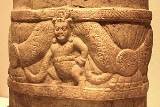
Amaravati, Andhra Pradesh
Encyclopedia
Amaravathi is a small town situated on the banks of the River Krishna in the Guntur District
(of which it is a mandal
) of Andhra Pradesh
, India
. It is famous for its Amareswara temple dedicated to Lord Shiva. The temple is one of the famous Pancharamas. Amaravati, also known as Dhanyakataka/Dharanikota
was the site of a great Buddhist Stupa
built in pre-Mauryan times. It was also the capital of Satavahana
s, the first great Andhra
kings who ruled from the 2nd century BCE to the 3rd century CE, after the downfall of Maurya empire.
gives a picture of the place and the Siva
temple located here. Sage Narada
explains to Sounaka and other saints that Amareswara is situated in Amareswaram on the bank of river Krishna
and is on the southeastern side of the Srisailam
temple.
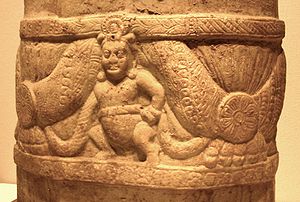 According to Vajrayana
According to Vajrayana
traditional sources the Buddha
preached at Dharanikota
/Dhanyakatakam and conducted Kalachakra
ceremony, which would take the antiquity of Amaravati back to 500 BCE. Taranatha, the Buddhist monk writes: "On the full moon of the month Caitra in the year following his enlightenment, at the great stupa of Dhanyakataka, Buddha emanated the mandala of "The Glorious Lunar Mansions" (Kalachakra
). This shows that Dhanyakatakam (Amaravati) was a very important place at the time of composition of this tantra
. The recorded history of Amaravati and nearby Dharanikota
dates from 2nd century BCE. It was the capital of Andhra Satavahana
s who ruled from 2nd century BCE to 3rd century CE. After the decline of Satavahanas, Andhra Ikshvaku
s and later Pallava
kings ruled Krishna river
valley. Subsequently, Eastern Chalukyas and Telugu Cholas
held sway over the region. Kota Kings
were in control of Amaravati during the medieval times. Kota kings were subdued by Kakatiya
s in 11th century CE and Amaravati became part of the unified Telugu empire.
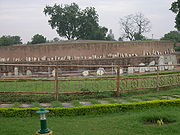
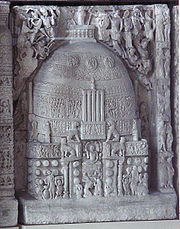
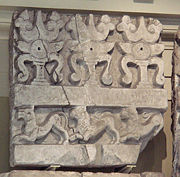 The town was the site of a great Buddhist
The town was the site of a great Buddhist
stupa
originally built during the reign of emperor Ashoka
. It was completed in 200 CE and is decorated with carved panels which tell the story of Buddha's life. The region between Krishna
and Godavari rivers was an important place for Buddhism
from the 2nd century BCE and some ancient sculpture in low relief has been found here. During the Satavahana
period (2nd century BCE-3rd century CE), Dharanikota
near Amaravati was chosen as the capital. The stupa was then adorned with limestone reliefs and free standing Buddha figures. During the period of the decline of Buddhism
, this stupa was also neglected and it was buried under rubble. There is a 14th century inscription in Sri Lanka
which mentions repairs made to the stupa and after that it was forgotten.
Around the year 1796 CE, Colonel Colin Mackenzie, who visited the site twice, prepared drawings and sketches of the relics in the area. Eventually, several European scholars including Sir Walter Smith, Robert Sewell, James Burgess and Alexander Rea excavated the site and unearthed many sculptures that once adorned the stupa. Many bas-relief medallions and paneled friezes decorated the Amaravati stupa. Similar to Sanchi Stupa, the stupa was decorated with carvings of life and teachings of Buddha and events of Jataka Stories, e.g. taming of a rogue elephant by Buddha. The 95 ft tall stupa was made of brick with a circular dome and platforms protruding in four cardinal directions. Recent excavations have revealed remains of an Ashoka
n pillar, the first such example of Mauryan art
to be found in South India
.
This stupa is related to the Vajrayana
teachings of Kalachakra
, still practiced today in Tibetan Buddhism
. According to the Kalachakra tantra
texts, Suchandra
, the King of Shambhala
and many of his retinue received the initiation into this practice by the historical Buddha
. For this reason, the Dalai Lama
of Tibet
conducted a Kalachakra initiation at this location in 2006.
Art historians regard the Amaravati art as one of the three major styles or schools of ancient Indian art, the other two being the Gandhara
style and the Mathura style. Some of the Buddhist sculptures of Amaravati betray a Greco-Roman influence that was the direct result of the close trade and diplomatic contacts between South India
and the ancient Roman
s. Indeed, Amaravati has itself yielded a few Roman coins. The Government Museum at Egmore (Madras Museum) and British Museum, London host the "Amaravati Gallery".
Chinese
traveller and Buddhist monk Hiuen Tsang (Xuanzang
) visited Amaravati in 640 CE, stayed for sometime and studied 'Abhidhammapitakam'. He observed that there were many Viharas and some of them were deserted, which points out that Hinduism
was gaining ground at that time. Xuanzang
wrote a glorious account of the place, Vihara
s and monasteries that existed.
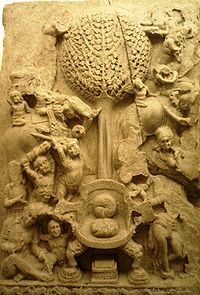 The Amaravati school of Dravidian art had great influence on art in Sri Lanka
The Amaravati school of Dravidian art had great influence on art in Sri Lanka
and South-East Asia as products from here were carried to those countries. Trade between the dynasties of Tamilakam
led to cultural exchange in the Sangam period. Sculptures such as the Vallipuram
Buddha reveal a period of influence between Andhra and Jaffna
at this time. In a pioneering study and meticulous documentation of the Buddhist sculptures of Sri Lanka, Dr. Ulrich Von Schroeder has listed up with measurements several lime stone sculptures, both round and in relief, from the Sri Lankan sites. The chapters in the work clearly go with a heading 'Imported Sculptures from Early Amaravati School', and 'Imported Sculptures from late Amaravati (Nagarjunakonda)'. It is clear that the artist guilds in Amaravati-Nagarjunakonda were engaged in the large scale supply of Buddhist sculptures, as also brahmanical, to Sri Lanka
and other South-Asian countries.
Religious ideology was a potent force providing cohesion and identity to trading communities and it was perhaps through these channels that the early Buddhist/ Brahmanical images found their way into South-East Asia and Sri Lanka
. At Sempaga in Celebes, a bronze image of Buddha of the Amaravati School was found. The earliest sculptures from Dong-Duong. Dong Tuk (Siam), exhibit Amaravati style. A bronze Buddha from South Djember and Sikendeng on the west coast of Celebes, and the colossal statue at Bukit are all in characteristic Amaravati style. It is quite likely that these image were brought from Andhra centers by the colonists. The transport of the large stone Buddha of Palembang must have been more difficult. It is the oldest relic from Amaravati in the archipelago. Sea route voyages connected Indian ports of the South such as Machilipatnam
, Ghantasala
etc., with Indonesia. Amaravati school also had a great influence over other South India
n sculpture.
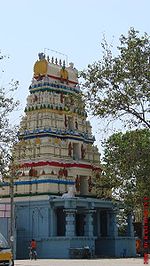 The Amareswara (Shiva) temple walls have lot of inscriptions that give information about the kings who ruled over the area. The present holy shrine of Amaralingeswara (Lord Shiva
The Amareswara (Shiva) temple walls have lot of inscriptions that give information about the kings who ruled over the area. The present holy shrine of Amaralingeswara (Lord Shiva
) temple is associated with the reign of Vasireddy Venkatadri Nayudu
who ruled the region before the advent of the British rule (See Amararama
). People around Amaravati widely believe that the temple was constructed to install peace after a massacre of 1000 violent tribesman plotting against the king in a sinister carnival organized to capture them. Later Venkatadri Nayudu built a temple in the same spot upon guidance from scholars of his court. He was well-known for his benevolence , munificence and construction of a large number of temples and education centers in the Krishna river
delta.
.
hb
. Amaravati is located 35 km northwest of Guntur
. It is connected by the Amaravati road from the heart of Guntur
. It is 46 km south west of Vijayawada
. Gannavaram
, north of Vijayawada
is the nearest airport.
 The people speak Telugu
The people speak Telugu
. The common traditional clothing for women is a Saree and for men a Pancha
or a Lungi
. The town was given a hagiographic portrayal in the famous short story series Amaravati Kathalu
by
Satyam Sankaramanchi
. The stories describe the contemporary culture of local people during the reign of Vasireddy Venkatadri Nayudu
and also post-independent times.
The town is a centre of piligrimage to both Hindus and Buddhists. Amaravati is also famous for the temple dedicated to the god Shiva
. The main Hindu festivals celebrated are Mahashivaratri and the Navaratri. The 30th Kalachakra
festival, a popular buddhist ritual was held at Amaravati in the first week of January 2006.
Guntur district
Guntur district is located in Andhra Pradesh along the east coast of Bay of Bengal. The district has a coastline of around 100 kilometers. Guntur City is the largest city in the district and administrative center of Guntur District. The district is a major center for learning.-Etymology:There are...
(of which it is a mandal
Subdivisions of India
The Administrative divisions of India are Indian subnational administrative units; they compose a nested hierarchy of country subdivisions. Indian states and territories frequently use different local titles for the same level of subdivision The Administrative divisions of India are Indian...
) of Andhra Pradesh
Andhra Pradesh
Andhra Pradesh , is one of the 28 states of India, situated on the southeastern coast of India. It is India's fourth largest state by area and fifth largest by population. Its capital and largest city by population is Hyderabad.The total GDP of Andhra Pradesh is $100 billion and is ranked third...
, India
India
India , officially the Republic of India , is a country in South Asia. It is the seventh-largest country by geographical area, the second-most populous country with over 1.2 billion people, and the most populous democracy in the world...
. It is famous for its Amareswara temple dedicated to Lord Shiva. The temple is one of the famous Pancharamas. Amaravati, also known as Dhanyakataka/Dharanikota
Dharanikota
Dharanikota or Dhanyakatakam or Palden Drepung is a town near Amaravati in the Guntur district of Andhra Pradesh in India, which means a town of rice or paddy.- Location :...
was the site of a great Buddhist Stupa
Stupa
A stupa is a mound-like structure containing Buddhist relics, typically the remains of Buddha, used by Buddhists as a place of worship....
built in pre-Mauryan times. It was also the capital of Satavahana
Satavahana
The Sātavāhana Empire or Andhra Empire, was a royal Indian dynasty based from Dharanikota and Amaravati in Andhra Pradesh as well as Junnar and Prathisthan in Maharashtra. The territory of the empire covered much of India from 230 BCE onward...
s, the first great Andhra
Andhra Pradesh
Andhra Pradesh , is one of the 28 states of India, situated on the southeastern coast of India. It is India's fourth largest state by area and fifth largest by population. Its capital and largest city by population is Hyderabad.The total GDP of Andhra Pradesh is $100 billion and is ranked third...
kings who ruled from the 2nd century BCE to the 3rd century CE, after the downfall of Maurya empire.
Legends
The Skanda PuranaSkanda Purana
The Skanda Purana is the largest Mahapurana, a genre of eighteen Hindu religious texts. The text is devoted mainly to the lilas of Kartikeya , a son of Shiva and Parvati. It also contains a number of legends about Shiva, and the holy places associated with him...
gives a picture of the place and the Siva
Shiva
Shiva is a major Hindu deity, and is the destroyer god or transformer among the Trimurti, the Hindu Trinity of the primary aspects of the divine. God Shiva is a yogi who has notice of everything that happens in the world and is the main aspect of life. Yet one with great power lives a life of a...
temple located here. Sage Narada
Narada
Narada or Narada Muni is a divine sage from the Vaisnava tradition, who plays a prominent role in a number of the Puranic texts, especially in the Bhagavata Purana, and in the Ramayana...
explains to Sounaka and other saints that Amareswara is situated in Amareswaram on the bank of river Krishna
Krishna
Krishna is a central figure of Hinduism and is traditionally attributed the authorship of the Bhagavad Gita. He is the supreme Being and considered in some monotheistic traditions as an Avatar of Vishnu...
and is on the southeastern side of the Srisailam
Srisailam
Srisailam is a holy town and mandal, situated in Nallamala Hills of Kurnool district, Andhra Pradesh, India. It is located on the banks of River Krishna, about 232 km south of Hyderabad....
temple.
History

Vajrayana
Vajrayāna Buddhism is also known as Tantric Buddhism, Tantrayāna, Mantrayāna, Secret Mantra, Esoteric Buddhism and the Diamond Vehicle...
traditional sources the Buddha
Gautama Buddha
Siddhārtha Gautama was a spiritual teacher from the Indian subcontinent, on whose teachings Buddhism was founded. In most Buddhist traditions, he is regarded as the Supreme Buddha Siddhārtha Gautama (Sanskrit: सिद्धार्थ गौतम; Pali: Siddhattha Gotama) was a spiritual teacher from the Indian...
preached at Dharanikota
Dharanikota
Dharanikota or Dhanyakatakam or Palden Drepung is a town near Amaravati in the Guntur district of Andhra Pradesh in India, which means a town of rice or paddy.- Location :...
/Dhanyakatakam and conducted Kalachakra
Kalachakra
Kalachakra is a Sanskrit term used in Tantric Buddhism that literally means "time-wheel" or "time-cycles".The spelling Kalacakra is also correct....
ceremony, which would take the antiquity of Amaravati back to 500 BCE. Taranatha, the Buddhist monk writes: "On the full moon of the month Caitra in the year following his enlightenment, at the great stupa of Dhanyakataka, Buddha emanated the mandala of "The Glorious Lunar Mansions" (Kalachakra
Kalachakra
Kalachakra is a Sanskrit term used in Tantric Buddhism that literally means "time-wheel" or "time-cycles".The spelling Kalacakra is also correct....
). This shows that Dhanyakatakam (Amaravati) was a very important place at the time of composition of this tantra
Tantra
Tantra , anglicised tantricism or tantrism or tantram, is the name scholars give to an inter-religious spiritual movement that arose in medieval India, expressed in scriptures ....
. The recorded history of Amaravati and nearby Dharanikota
Dharanikota
Dharanikota or Dhanyakatakam or Palden Drepung is a town near Amaravati in the Guntur district of Andhra Pradesh in India, which means a town of rice or paddy.- Location :...
dates from 2nd century BCE. It was the capital of Andhra Satavahana
Satavahana
The Sātavāhana Empire or Andhra Empire, was a royal Indian dynasty based from Dharanikota and Amaravati in Andhra Pradesh as well as Junnar and Prathisthan in Maharashtra. The territory of the empire covered much of India from 230 BCE onward...
s who ruled from 2nd century BCE to 3rd century CE. After the decline of Satavahanas, Andhra Ikshvaku
Andhra Ikshvaku
The Andhra Ikshvakus were one of the earliest recorded ruling dynasties of Andhra Pradesh and are said to have been the first Kshatriya rulers in the Andhra region. They ruled the eastern Andhra country along the Krishna river during the later half of the 2nd century CE. . Their capital was...
s and later Pallava
Pallava
The Pallava dynasty was a Tamil dynasty which ruled the northern Tamil Nadu region and the southern Andhra Pradesh region with their capital at Kanchipuram...
kings ruled Krishna river
Krishna River
The Krishna River , is one of the longest rivers in central-southern India, about . It is also referred to as Krishnaveni in its original nomenclature...
valley. Subsequently, Eastern Chalukyas and Telugu Cholas
Telugu Cholas
Many Telugu Choda kingdoms ruled over many regions including the cities on the banks of Krishna River in the period between the seventh and the thirteenth century. It is not known much about these family origins. Some of them claimed descent from the legendary Tamil Karikala Chola . Telugu Cholas...
held sway over the region. Kota Kings
Kota Vamsa
Kota Vamsa in Telugu means Fort Dynasty and is used to refer to the medieval dynasty which ruled over a small region of Andhra Pradesh with Dharanikota as their capital from around 8th century AD to the mid 12th century AD...
were in control of Amaravati during the medieval times. Kota kings were subdued by Kakatiya
Kakatiya
The Kakatiya dynasty was an Indian dynasty that ruled most parts of what is now Andhra Pradesh, India from 1083 CE to 1323 CE, with Orugallu , now Warangal , as its capital. Orugallu is also called 'Eka Sila Nagaram'...
s in 11th century CE and Amaravati became part of the unified Telugu empire.
The stupa



Buddhism
Buddhism is a religion and philosophy encompassing a variety of traditions, beliefs and practices, largely based on teachings attributed to Siddhartha Gautama, commonly known as the Buddha . The Buddha lived and taught in the northeastern Indian subcontinent some time between the 6th and 4th...
stupa
Stupa
A stupa is a mound-like structure containing Buddhist relics, typically the remains of Buddha, used by Buddhists as a place of worship....
originally built during the reign of emperor Ashoka
Ashoka
Ashok Maurya or Ashoka , popularly known as Ashoka the Great, was an Indian emperor of the Maurya Dynasty who ruled almost all of the Indian subcontinent from ca. 269 BC to 232 BC. One of India's greatest emperors, Ashoka reigned over most of present-day India after a number of military conquests...
. It was completed in 200 CE and is decorated with carved panels which tell the story of Buddha's life. The region between Krishna
Krishna
Krishna is a central figure of Hinduism and is traditionally attributed the authorship of the Bhagavad Gita. He is the supreme Being and considered in some monotheistic traditions as an Avatar of Vishnu...
and Godavari rivers was an important place for Buddhism
Buddhism
Buddhism is a religion and philosophy encompassing a variety of traditions, beliefs and practices, largely based on teachings attributed to Siddhartha Gautama, commonly known as the Buddha . The Buddha lived and taught in the northeastern Indian subcontinent some time between the 6th and 4th...
from the 2nd century BCE and some ancient sculpture in low relief has been found here. During the Satavahana
Satavahana
The Sātavāhana Empire or Andhra Empire, was a royal Indian dynasty based from Dharanikota and Amaravati in Andhra Pradesh as well as Junnar and Prathisthan in Maharashtra. The territory of the empire covered much of India from 230 BCE onward...
period (2nd century BCE-3rd century CE), Dharanikota
Dharanikota
Dharanikota or Dhanyakatakam or Palden Drepung is a town near Amaravati in the Guntur district of Andhra Pradesh in India, which means a town of rice or paddy.- Location :...
near Amaravati was chosen as the capital. The stupa was then adorned with limestone reliefs and free standing Buddha figures. During the period of the decline of Buddhism
Buddhism
Buddhism is a religion and philosophy encompassing a variety of traditions, beliefs and practices, largely based on teachings attributed to Siddhartha Gautama, commonly known as the Buddha . The Buddha lived and taught in the northeastern Indian subcontinent some time between the 6th and 4th...
, this stupa was also neglected and it was buried under rubble. There is a 14th century inscription in Sri Lanka
Sri Lanka
Sri Lanka, officially the Democratic Socialist Republic of Sri Lanka is a country off the southern coast of the Indian subcontinent. Known until 1972 as Ceylon , Sri Lanka is an island surrounded by the Indian Ocean, the Gulf of Mannar and the Palk Strait, and lies in the vicinity of India and the...
which mentions repairs made to the stupa and after that it was forgotten.
Around the year 1796 CE, Colonel Colin Mackenzie, who visited the site twice, prepared drawings and sketches of the relics in the area. Eventually, several European scholars including Sir Walter Smith, Robert Sewell, James Burgess and Alexander Rea excavated the site and unearthed many sculptures that once adorned the stupa. Many bas-relief medallions and paneled friezes decorated the Amaravati stupa. Similar to Sanchi Stupa, the stupa was decorated with carvings of life and teachings of Buddha and events of Jataka Stories, e.g. taming of a rogue elephant by Buddha. The 95 ft tall stupa was made of brick with a circular dome and platforms protruding in four cardinal directions. Recent excavations have revealed remains of an Ashoka
Ashoka
Ashok Maurya or Ashoka , popularly known as Ashoka the Great, was an Indian emperor of the Maurya Dynasty who ruled almost all of the Indian subcontinent from ca. 269 BC to 232 BC. One of India's greatest emperors, Ashoka reigned over most of present-day India after a number of military conquests...
n pillar, the first such example of Mauryan art
Mauryan art
Mauryan art encompasses the arts produced during the period of the Mauryan Empire , which was the first empire to rule over most of the Indian subcontinent. It represented an important transition in Indian art from use of wood to stone...
to be found in South India
South India
South India is the area encompassing India's states of Andhra Pradesh, Karnataka, Kerala and Tamil Nadu as well as the union territories of Lakshadweep and Pondicherry, occupying 19.31% of India's area...
.
This stupa is related to the Vajrayana
Vajrayana
Vajrayāna Buddhism is also known as Tantric Buddhism, Tantrayāna, Mantrayāna, Secret Mantra, Esoteric Buddhism and the Diamond Vehicle...
teachings of Kalachakra
Kalachakra
Kalachakra is a Sanskrit term used in Tantric Buddhism that literally means "time-wheel" or "time-cycles".The spelling Kalacakra is also correct....
, still practiced today in Tibetan Buddhism
Tibetan Buddhism
Tibetan Buddhism is the body of Buddhist religious doctrine and institutions characteristic of Tibet and certain regions of the Himalayas, including northern Nepal, Bhutan, and India . It is the state religion of Bhutan...
. According to the Kalachakra tantra
Tantra
Tantra , anglicised tantricism or tantrism or tantram, is the name scholars give to an inter-religious spiritual movement that arose in medieval India, expressed in scriptures ....
texts, Suchandra
Suchandra
According to Indian and Tibetan legend, King Suchandra of the northeastern Indian Kingdom of Shambhala was the one who requested teaching from the Buddha that would allow him to practice the dharma without renouncing his worldly enjoyments and responsibilities...
, the King of Shambhala
Kings of Shambhala
In the Indo-Tibetan Vajrayana Buddhist tradition, there are thirty-two Kings of Shambhala, a mythical kingdom.The first notable king of Shambhala, King Suchandra , was the one who requested teaching from the Buddha. In response to his request, the Buddha gave the first Kalachakra root tantra...
and many of his retinue received the initiation into this practice by the historical Buddha
Buddha
In Buddhism, buddhahood is the state of perfect enlightenment attained by a buddha .In Buddhism, the term buddha usually refers to one who has become enlightened...
. For this reason, the Dalai Lama
Dalai Lama
The Dalai Lama is a high lama in the Gelug or "Yellow Hat" branch of Tibetan Buddhism. The name is a combination of the Mongolian word далай meaning "Ocean" and the Tibetan word bla-ma meaning "teacher"...
of Tibet
Tibet
Tibet is a plateau region in Asia, north-east of the Himalayas. It is the traditional homeland of the Tibetan people as well as some other ethnic groups such as Monpas, Qiang, and Lhobas, and is now also inhabited by considerable numbers of Han and Hui people...
conducted a Kalachakra initiation at this location in 2006.
Art historians regard the Amaravati art as one of the three major styles or schools of ancient Indian art, the other two being the Gandhara
Gandhara
Gandhāra , is the name of an ancient kingdom , located in northern Pakistan and eastern Afghanistan. Gandhara was located mainly in the vale of Peshawar, the Potohar plateau and on the Kabul River...
style and the Mathura style. Some of the Buddhist sculptures of Amaravati betray a Greco-Roman influence that was the direct result of the close trade and diplomatic contacts between South India
South India
South India is the area encompassing India's states of Andhra Pradesh, Karnataka, Kerala and Tamil Nadu as well as the union territories of Lakshadweep and Pondicherry, occupying 19.31% of India's area...
and the ancient Roman
Ancient Rome
Ancient Rome was a thriving civilization that grew on the Italian Peninsula as early as the 8th century BC. Located along the Mediterranean Sea and centered on the city of Rome, it expanded to one of the largest empires in the ancient world....
s. Indeed, Amaravati has itself yielded a few Roman coins. The Government Museum at Egmore (Madras Museum) and British Museum, London host the "Amaravati Gallery".
Chinese
China
Chinese civilization may refer to:* China for more general discussion of the country.* Chinese culture* Greater China, the transnational community of ethnic Chinese.* History of China* Sinosphere, the area historically affected by Chinese culture...
traveller and Buddhist monk Hiuen Tsang (Xuanzang
Xuanzang
Xuanzang was a famous Chinese Buddhist monk, scholar, traveler, and translator who described the interaction between China and India in the early Tang period...
) visited Amaravati in 640 CE, stayed for sometime and studied 'Abhidhammapitakam'. He observed that there were many Viharas and some of them were deserted, which points out that Hinduism
Hinduism
Hinduism is the predominant and indigenous religious tradition of the Indian Subcontinent. Hinduism is known to its followers as , amongst many other expressions...
was gaining ground at that time. Xuanzang
Xuanzang
Xuanzang was a famous Chinese Buddhist monk, scholar, traveler, and translator who described the interaction between China and India in the early Tang period...
wrote a glorious account of the place, Vihara
Vihara
Vihara is the Sanskrit and Pali term for a Buddhist monastery. It originally meant "a secluded place in which to walk", and referred to "dwellings" or "refuges" used by wandering monks during the rainy season....
s and monasteries that existed.
Amaravati School

Sri Lanka
Sri Lanka, officially the Democratic Socialist Republic of Sri Lanka is a country off the southern coast of the Indian subcontinent. Known until 1972 as Ceylon , Sri Lanka is an island surrounded by the Indian Ocean, the Gulf of Mannar and the Palk Strait, and lies in the vicinity of India and the...
and South-East Asia as products from here were carried to those countries. Trade between the dynasties of Tamilakam
Tamilakam
' refers to the classical era territory of old South Indian royalties covering modern Tamil Nadu, Kerala, Tamil Eelam and southern parts of Andhra Pradesh, Karnataka.; In an academic context, Tamilakam is used to refer to these territories as a single cultural area, where Tamil was the natural...
led to cultural exchange in the Sangam period. Sculptures such as the Vallipuram
Vallipuram
Vallipuram was an ancient capital of Northern Kingdoms of Sri Lanka. Point Pedro is the nearest town. Vallipuram is a part of Thunnalai.This place is settled by migrants from a town called Vallipuram near Namakkal which is near Coimbatore. Naga names are found in India. Nagpur, Nagar Kovil,...
Buddha reveal a period of influence between Andhra and Jaffna
Jaffna
Jaffna is the capital city of the Northern Province, Sri Lanka. It is the administrative headquarters of the Jaffna district located on a peninsula of the same name. Jaffna is approximately six miles away from Kandarodai which served as a famous emporium in the Jaffna peninsula from classical...
at this time. In a pioneering study and meticulous documentation of the Buddhist sculptures of Sri Lanka, Dr. Ulrich Von Schroeder has listed up with measurements several lime stone sculptures, both round and in relief, from the Sri Lankan sites. The chapters in the work clearly go with a heading 'Imported Sculptures from Early Amaravati School', and 'Imported Sculptures from late Amaravati (Nagarjunakonda)'. It is clear that the artist guilds in Amaravati-Nagarjunakonda were engaged in the large scale supply of Buddhist sculptures, as also brahmanical, to Sri Lanka
Sri Lanka
Sri Lanka, officially the Democratic Socialist Republic of Sri Lanka is a country off the southern coast of the Indian subcontinent. Known until 1972 as Ceylon , Sri Lanka is an island surrounded by the Indian Ocean, the Gulf of Mannar and the Palk Strait, and lies in the vicinity of India and the...
and other South-Asian countries.
Religious ideology was a potent force providing cohesion and identity to trading communities and it was perhaps through these channels that the early Buddhist/ Brahmanical images found their way into South-East Asia and Sri Lanka
Sri Lanka
Sri Lanka, officially the Democratic Socialist Republic of Sri Lanka is a country off the southern coast of the Indian subcontinent. Known until 1972 as Ceylon , Sri Lanka is an island surrounded by the Indian Ocean, the Gulf of Mannar and the Palk Strait, and lies in the vicinity of India and the...
. At Sempaga in Celebes, a bronze image of Buddha of the Amaravati School was found. The earliest sculptures from Dong-Duong. Dong Tuk (Siam), exhibit Amaravati style. A bronze Buddha from South Djember and Sikendeng on the west coast of Celebes, and the colossal statue at Bukit are all in characteristic Amaravati style. It is quite likely that these image were brought from Andhra centers by the colonists. The transport of the large stone Buddha of Palembang must have been more difficult. It is the oldest relic from Amaravati in the archipelago. Sea route voyages connected Indian ports of the South such as Machilipatnam
Machilipatnam
Machilipatnam is a city and a special grade municipality in the Krishna district, Andhra Pradesh, India. It is located south east of state capital, Hyderabad.-History:...
, Ghantasala
Ghantasala (town)
Ghantasala , is a town and Mandal headquarters in Krishna district of Andhra Pradesh, India. It is 21 km west of Machilipatnam and 11 km east of river krishna.The largest city of this district, Vijaywada, is around 60 km away. It is a rare and reputed center for Buddhist sculptures....
etc., with Indonesia. Amaravati school also had a great influence over other South India
South India
South India is the area encompassing India's states of Andhra Pradesh, Karnataka, Kerala and Tamil Nadu as well as the union territories of Lakshadweep and Pondicherry, occupying 19.31% of India's area...
n sculpture.
Shiva Temple

Shiva
Shiva is a major Hindu deity, and is the destroyer god or transformer among the Trimurti, the Hindu Trinity of the primary aspects of the divine. God Shiva is a yogi who has notice of everything that happens in the world and is the main aspect of life. Yet one with great power lives a life of a...
) temple is associated with the reign of Vasireddy Venkatadri Nayudu
Vasireddy Venkatadri Nayudu
Vasireddy Venkatadri Nayudu was the last king of the Vasireddy Clan that ruled parts of coastal Andhra Pradesh from 1413 until the advent of the British. He was popularly known as the first king who revolted against British in India. The original seat of power was Chintapalli in present-day...
who ruled the region before the advent of the British rule (See Amararama
Amararama
Amararama is one of the Pancharama Kshetras which is located at Amaravati town near Guntur City in Andhra Pradesh in South India. Lord Shiva is known as Amareswara Swamy or Amaralingeswara Swamy here. The temple is situated on the southern bank of Krishna River. The consort of Lord Amareswara...
). People around Amaravati widely believe that the temple was constructed to install peace after a massacre of 1000 violent tribesman plotting against the king in a sinister carnival organized to capture them. Later Venkatadri Nayudu built a temple in the same spot upon guidance from scholars of his court. He was well-known for his benevolence , munificence and construction of a large number of temples and education centers in the Krishna river
Krishna River
The Krishna River , is one of the longest rivers in central-southern India, about . It is also referred to as Krishnaveni in its original nomenclature...
delta.
Geography
The city is located at 16°34′N 80°22′E on the south bank of Krishna riverKrishna River
The Krishna River , is one of the longest rivers in central-southern India, about . It is also referred to as Krishnaveni in its original nomenclature...
.
hb
Transport
It is reachable by road or by boat / coracle on the Krishna RiverKrishna River
The Krishna River , is one of the longest rivers in central-southern India, about . It is also referred to as Krishnaveni in its original nomenclature...
. Amaravati is located 35 km northwest of Guntur
Guntur
Guntur , is a city and a municipal corporation in the Indian state of Andhra Pradesh, located to the north and west of the Bay of Bengal. It is approximately to the south of the national capital, New Delhi and south east of state capital, Hyderabad. Guntur is the fourth largest city in Andhra...
. It is connected by the Amaravati road from the heart of Guntur
Guntur
Guntur , is a city and a municipal corporation in the Indian state of Andhra Pradesh, located to the north and west of the Bay of Bengal. It is approximately to the south of the national capital, New Delhi and south east of state capital, Hyderabad. Guntur is the fourth largest city in Andhra...
. It is 46 km south west of Vijayawada
Vijayawada
Vijayawada is the third largest city in Andhra Pradesh, India, located on the banks of the Krishna River and bounded by the Indrakiladri Hills on the West and the Budameru River on the North. The city is located in the Krishna District, about from the state capital Hyderabad.Vijayawada literally...
. Gannavaram
Gannavaram
Gannavaram is a town and a mandal headquarter located in Krishna district of Andhra Pradesh, India. It is situated at a distance of 20 kilometers from the city of Vijayawada on National Highway 5 connecting Chennai to Kolkata. Gannavaram is known for its airport and weather reporting...
, north of Vijayawada
Vijayawada
Vijayawada is the third largest city in Andhra Pradesh, India, located on the banks of the Krishna River and bounded by the Indrakiladri Hills on the West and the Budameru River on the North. The city is located in the Krishna District, about from the state capital Hyderabad.Vijayawada literally...
is the nearest airport.
Culture

Telugu language
Telugu is a Central Dravidian language primarily spoken in the state of Andhra Pradesh, India, where it is an official language. It is also spoken in the neighbouring states of Chattisgarh, Karnataka, Maharashtra, Orissa and Tamil Nadu...
. The common traditional clothing for women is a Saree and for men a Pancha
Dhoti
The dhoti or pancha is the traditional men's garment in the in India, Bangladesh and Sri Lanka. A similar garment is worn in some rural areas of Punjab province in Pakistan, but the use is fast declining...
or a Lungi
Lungi
The Lungi , also known as a sarong , is a traditional garment worn around the waist in India, Pakistan, Bangladesh, Sri Lanka, Burma, Brunei, Indonesia, Malaysia, Singapore, the Horn of Africa and the southern Arabian Peninsula...
. The town was given a hagiographic portrayal in the famous short story series Amaravati Kathalu
Amaravati Kathalu
Amaravati Kathalu is a collection of Telugu short stories written by Satyam Sankaramanchi.The stories are about the people of the village of Amaravati and were first published in the AandhraJoyti newspaper. The series ran for two years...
by
Satyam Sankaramanchi
Sankaramanchi
Satyam Sankaramanchi is a storyteller who was born in the tiny village of Amaravati near Guntur City, in Andhra Pradesh, India. He started telling all of his stories by weaving a whole new world around this tiny village Amaravati...
. The stories describe the contemporary culture of local people during the reign of Vasireddy Venkatadri Nayudu
Vasireddy Venkatadri Nayudu
Vasireddy Venkatadri Nayudu was the last king of the Vasireddy Clan that ruled parts of coastal Andhra Pradesh from 1413 until the advent of the British. He was popularly known as the first king who revolted against British in India. The original seat of power was Chintapalli in present-day...
and also post-independent times.
The town is a centre of piligrimage to both Hindus and Buddhists. Amaravati is also famous for the temple dedicated to the god Shiva
Shiva
Shiva is a major Hindu deity, and is the destroyer god or transformer among the Trimurti, the Hindu Trinity of the primary aspects of the divine. God Shiva is a yogi who has notice of everything that happens in the world and is the main aspect of life. Yet one with great power lives a life of a...
. The main Hindu festivals celebrated are Mahashivaratri and the Navaratri. The 30th Kalachakra
Kalachakra
Kalachakra is a Sanskrit term used in Tantric Buddhism that literally means "time-wheel" or "time-cycles".The spelling Kalacakra is also correct....
festival, a popular buddhist ritual was held at Amaravati in the first week of January 2006.
Villages
Villages in Amaravati mandal are:- Munugodu
- Tura-gavari-palem
- Amaravati
- AttalurAttalurAttalur is a village situated near Amaravathi in the Guntur District of Andhra Pradesh, India. Which plays prominent role in Pedakurapadu Assembly constituency's political and social issues. This village has one sivaru village namely Nuthalapativari Palem. It has nearly 8000 residents in 900...
- Jupudi
- Chavu-paduChavupaduChavupadu is a village near Amaravati in Guntur district of Andhra Pradesh. This village has historical significance with Vasireddy clan.Famous Telugu film actor M. Balaiah was born in this village....
- Didugu
- Linga-puram
- Muttaya-palem
- MalladiMalladiMalladi is a village in Amaravati mandal of Guntur district, Andhra Pradesh, India.Bhavirisetty Hanumatha Rao is the sarpanch of the village.It has around 500 houses in the village. The main occupation of the village is agriculture. The village depends on Krishna river water for irrigation...
- Mande-pudi
- Pondu-gula
- Dharani-kota
- Nara-kulla-padu
- Vy-kunta-puram
- Pedda-madduru
- Endroyi
- Unguturu
- Nemali-kallu
- Karala-pudi
- LemalleLemalleLemalle is a village in Guntur district, Andhra Pradesh, India on the way to Amaravati from Guntur.14th Mile is also part of Lemalle grama panchayat and commercial area of this village....
- Enika-padu
- Nadellavari Village

